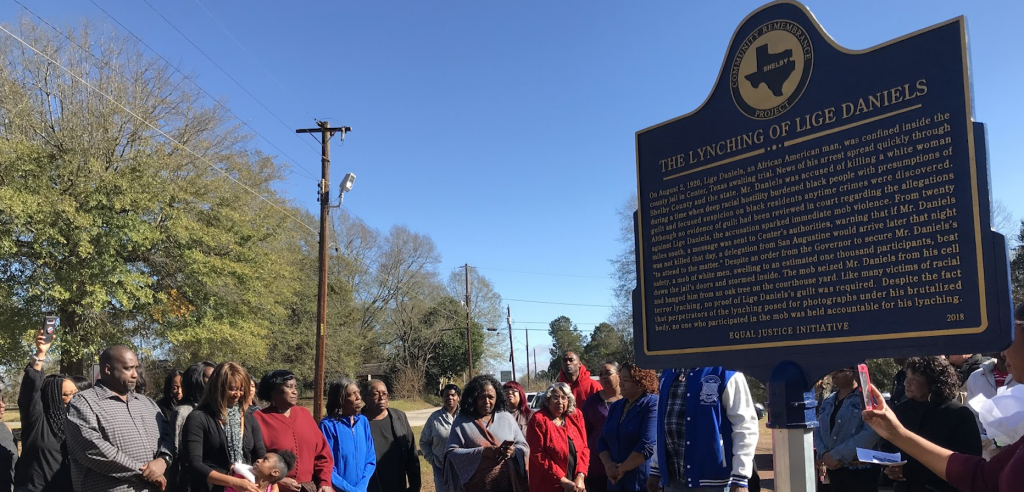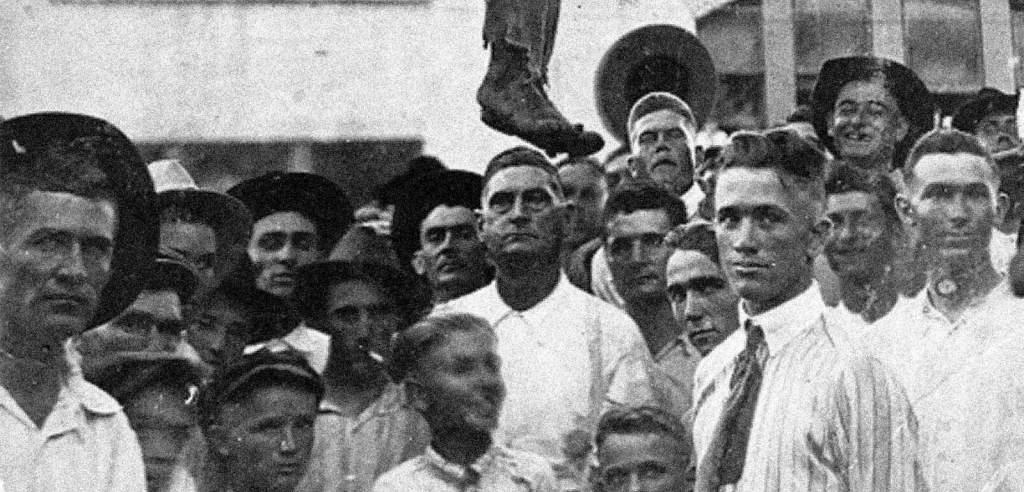On Saturday, December 15, community members and civil rights leaders gathered with EJI staff in Center, Texas, to unveil a historical marker memorializing Lige Daniels, a 16-year-old victim of a racial terror lynching in 1920, as part of EJI’s Community Remembrance Project.
Community members gathered at the corner of the town square near the tree where Lige Daniels was lynched – near the old Shelby County Courthouse. Community leader Delbert Jackson and EJI staff collected the soil in a solemn ceremony honoring Mr. Daniels while providing reflections on how communities must talk about the trauma of racial terror in order to heal.
EJI Staff and Community Members after the Soil Collection in honor of Lige Daniels (holding jar is community leader Delbert Jackson). Photo by Belinda Brewer.
After the soil collection, approximately 60 community members gathered at Triumph Church and walked to the historical marker. Mr. Jackson spoke to the crowd and explained the difficulties he faced from local officials and the resistance to placing the historical marker on the courthouse lawn; he expressed hopes that the next generation would succeed in getting the marker moved to the correct location. After the unveiling of the historical marker, Vanessa Davis of the Shelby County Historical Commission announced that nine family members of Lige Daniels were present.
Community members returned to Triumph Church for the full program, which included performances from the local praise and dance team and Christian rapper Michael Lyons. The audience also heard from keynote speaker Cherry Steinwender, Executive Director of The Center for the Healing of Racism.
Mrs. Steinwender discussed that until we take seriously the damage caused by racism, we will remain a traumatized people, unable to resolve the issues that have been constructed through racism. In particular, Mrs. Steinwender addressed the ways in which racial terrorism was used as a method of indoctrination to white supremacy, as white residents who participated in the mob brought their children to the public spectacle lynching of Mr. Daniels, as well, and that more should be done to examine the consequences of participating in mob violence.
EJI announced the winners of our Racial Justice Essay Contest and awarded them $5000 in scholarships. The first place winner, Mark Perkins, read his essay which discussed issues of integration and some of his experiences as a biracial student. In fifth place was Raquel Rafael, in fourth place was Naquila Barnes, in third place was Jasmine Cooks, and in second place was Esther Mergerson.
The Lynching of Lige Daniels
On August 2, 1920, Lige Daniels was imprisoned on the allegations of murdering a white woman. While confined inside the county jail in Center, Texas, awaiting trial, news of his arrest spread quickly through Shelby County. Although no evidence of guilt had been reviewed in court regarding allegations against Lige Daniels, the accusation sparked immediate mob violence.
Community members demanded that Lige Daniels be killed. Despite an order from the Governor to secure Mr. Daniels’s safety, a mob of white men, swelling to an estimated one thousand participants, beat down the jails doors, seized Mr. Daniels and hanged him from an oak tree on the courthouse yard.
It was not uncommon for lynch mobs to seize their victims from jails, prisons, or courtrooms. Though they were armed and charged with protecting the people in their custody, police almost never used force to resist white lynch mobs intent on killing Black people. After the lynching, a photograph was taken where men and boys posed beneath Mr. Daniels’s body. This photo was made into a postcard and widely seen by community members; although the perpetrators were photographed, no one who participated in the mob was held accountable for his lynching.
A second hanging in 1928, of Eolis “Buddy” Evans, occurred on the same limb of the tree that Mr. Daniels was hanged. The dead limb was reportedly collected by a craftsman from Center, Texas, who made gavels of wood, some of which are still in use.
EJI’s Community Remembrance Project
EJI’s Community Remembrance Project is part of our campaign to recognize the victims of lynching by collecting soil from lynching sites, erecting historical markers, and developing the National Memorial for Peace and Justice which acknowledges the horrors of racial injustice.
As part of its effort to help towns, cities, and states confront and recover from tragic histories of racial violence and terrorism, EJI is joining with communities to install historical markers in communities where the history of lynching is documented. EJI believes that by reckoning with the truth of the racial violence that has shaped our communities, community members can begin a necessary conversation that advances healing and reconciliation.
Lynching in America
Thousands of Black people were the victims of lynching and racial violence in the United States between 1877 and 1950. The lynching of African Americans during this era was a form of racial terrorism intended to intimidate Black people and enforce racial hierarchy and segregation.
Lynching was most prevalent in the South including Alabama, Arkansas, Florida, Georgia, Kentucky, Louisiana, Mississippi, North Carolina, South Carolina, Tennessee, Texas, and Virginia. After the Civil War, violent resistance to equal rights for African Americans and an ideology of white supremacy led to violent abuse of racial minorities and decades of political, social, and economic exploitation.
In an expanded edition of Lynching in America, EJI also documented racial terrorism beyond Southern borders, detailing more than 300 lynchings of Black people in eight states with high lynching rates in the Midwest and the Upper South, including Oklahoma (76 lynchings), Missouri (60), Illinois (56), West Virginia (35), Maryland (28), Kansas (19), Indiana (18), and Ohio (15).
Lynching became the most public and notorious form of terror and subordination. White mobs were usually permitted to engage in racial terror and brutal violence with impunity. Many Black people were pulled out of jails or given over to mobs by law enforcement officials who were legally required to protect them. Terror lynchings often included burning and mutilation, sometimes in front of crowds numbering in the thousands.
In response to this racial terror and violence, millions of Black people fled the South and could never return, which deepened the anguish and pain of lynching. Many of the names of lynching victims were not recorded and will never be known, but EJI has documented over 330 documented lynchings of Black people in Texas alone, including Mr. Lige Daniels and Mr. Buddy Evans, who was lynched on May 21, 1928, in Shelby County, Texas.



